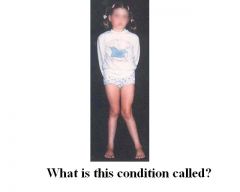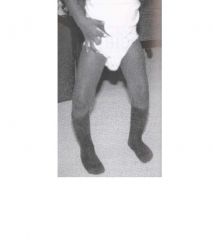![]()
![]()
![]()
Use LEFT and RIGHT arrow keys to navigate between flashcards;
Use UP and DOWN arrow keys to flip the card;
H to show hint;
A reads text to speech;
36 Cards in this Set
- Front
- Back
|
Define Dysplasia
|
Condition affecting growth or development
due to intrinsic defect (genetics) |
|
|
What are the two types of skeletal deformity and what is their difference?
|
Disproportionate
(Trunk & Extremities unequally affected) Proportionate (Trunk & Extremities equally affected) |
|
|
What is the most common form of skeletal Dysplasia?
|
Dwarfism
|
|
|
What is the most common form of Dwarfism?
|
Achondroplasia
|
|
|
What type of dysplasia is attributed to achondroplasia?
|
Disproportionate dysplasia
|
|
|
What is the etiology of Achondroplasia?
|
Point mutation in the gene encoding Fibroblast Growth Factor Receptor 3 (FGFR3)
|
|
|
T/F - Achondroplasia affects intermembranous ossification of the bones.
|
False. It affects the endochondral ossification (where pre-formed cartilage is replaced by calcification)
|
|
|
What are the characteristics of achondroplasia? x3
|
Spinal stenosis
Trident hand Disproportionate dwarfism |
|
|
Define dystrophy
|
Condition affecting growth/development due to extrinsic factors (malnutrition, hormone, or metabolism)
|
|
|
What is the etiology of Duchenne's Muscular Dystrophy?
|
Abnormality in gene encoding DYSTROPHIN
|
|
|
What are the clinical symptoms of Duchenne's muscular dystrophy starting at birth.
|
Normal at birth
Symptoms appear at approximately 18 months (Calf pseudohypertrophy) (Gower's manuever) |
|
|
Osteogenesis Imperfecta
- etiology |
Connective tissue disorder due to mutations in gene for Type I collagen
|
|
|
What are the symptoms of Osteogenesis Imperfecta? x3
|
Blue Sclerae
Abnormal Dentinogenesis Bone fragility = multiple fx |
|
|
What are the most common childhood deformities?
|
In-toeing & out-toeing
|
|
|
In-toeing:
- AKA - etiology - prognosis |
Metatarsus Adductus
Packaging defect in the womb 90% will spontaneously heal |
|
|
Clubfoot:
- AKA - characteristics x3 - etiology - treatment |
Talipes Equinovarus
Plantar flexion (equinus) Forefoot adductus Heel varus Germ plasm defect Manipulation/Casting Surgery |
|
|
Femoral Anteversion:
- character - prognosis |
Internal rotation of hip
Spontaneously heal 6-8 years |
|
|
Tibial Torsion
- character - prognosis |
Lateral malleolus is anterior or in the same plane as medial malleolus.
(normally, lateral malleolus is posterior to medial malleolus) Spontaneously heals |
|
|
At what age is in-toeing normal for children and why?
|
Prior to age four, it is normal
Femoral anteversion & tibial torsion |
|
|
Flatfoot:
- AKA - Character - Assessment test? - Prognosis - Treatment |
Pes Plano Valgus
Absent longitudinal arch Flexibility test Arch won't be there ever If arch seen in flexibility test, then no treatment. If no arch seen in flexibility test, then possible surgery due to Congenital Vertical Talus or Tarsal Coalition |
|
|
DDH
- what does it stand for? - incidence - risk factors x3 |
Development dysplasia of hip
1 : 1,000 First born female positive family hx. |
|
|
List two diagnostic tools for DDH.
|
Ortalani test
Barlow test |
|
|
SCFE:
- what does it stand for? - symptoms x3 - treatment |
Slipped Capped Femoral Epiphysis
Pain in hip External rotation of hip Deformity of hip Surgical pinning |
|
|
Legg-Perthes:
- etiology - risk factors x2 - clinical symptoms x4 - bilateral or unilateral? - treatment |
Idiopathic necrosis of femerol head
Males (4x's more than females) Age 2-12 (mostly 4-8 years old) Limp Ipsilateral knee pain Painful internal rotation No range of Motion 90% unilateral Containment of femoral head in acetabulum via surgery or bracing |
|
|
Genu Valgum
|

__________________________
|
|
|
Genu varum ("Bow legged")
Normal newborn variant Spontaneously heals at 3 y.o. If persists beyond 3 y.o., than rule out Blount's and Rickets |

What's this called?
Is this normal? Prognosis? Possible pathology? |
|
|
Scoliosis requirements
|
Greater than 10 degree lateral curvature
|
|
|
Classifications of Scoliosis. x3
|
Idiopathic
Congenital Neuromuscular |
|
|
Organisms responsible for Osteomyelitis
- most common - neonates - 6 mo. to 4 yrs - puncture wound pts |
Staphylococcus
Streptococcus I. Influenze (not so common now) Pseudomonas |
|
|
Symptoms of osteomyelitis. x4
|
Pain
Swelling Tenderness Psuedoparalysis |
|
|
What is a direct extension from adjacent osteomyelitis?
|
Septic arthritis
|
|
|
Septic arthritis
- how does it occur x2 - diagnostic tool |
Hematogenous seeding or
Direct extension from adjacent osteomyelitis Joint aspiration |
|
|
Septic arthritis
- treatment |
Aspiration/antibiotics
Hip surgery drainage |
|
|
Septic arthritis
- how does it occur x2 - diagnostic tool |
Hematogenous seeding or
Direct extension from adjacent osteomyelitis Joint aspiration |
|
|
Septic arthritis
- treatment |
Aspiration/antibiotics
Hip surgery drainage |
|
|
T/F - There is a potential death of physis in children
|
True
|

